University Industrial Relations: Penalty Rate Reduction Analysis Essay
VerifiedAdded on 2023/03/17
|12
|4337
|28
Essay
AI Summary
This essay examines the 2017 Australian Fair Work Commission ruling on penalty rate reductions for the hospitality, retail, and fast food industries. It identifies the key parties involved, including the Senate, various committees, and the Australian Fair Work Commission, and explains the reasons behind the ruling, such as addressing perceived inequities in penalty rates and protecting the Fair Work Amendments Bill of 2017. The essay analyzes the groups affected by the ruling, highlighting the disadvantaged, such as low-income workers, particularly women and young workers, who rely on penalty rates, and the potentially advantaged, like consumers who may benefit from extended business hours. It also explores the implications for both employees, including potential wage losses and hardship, and employers, considering the impact on labor costs and business operations.
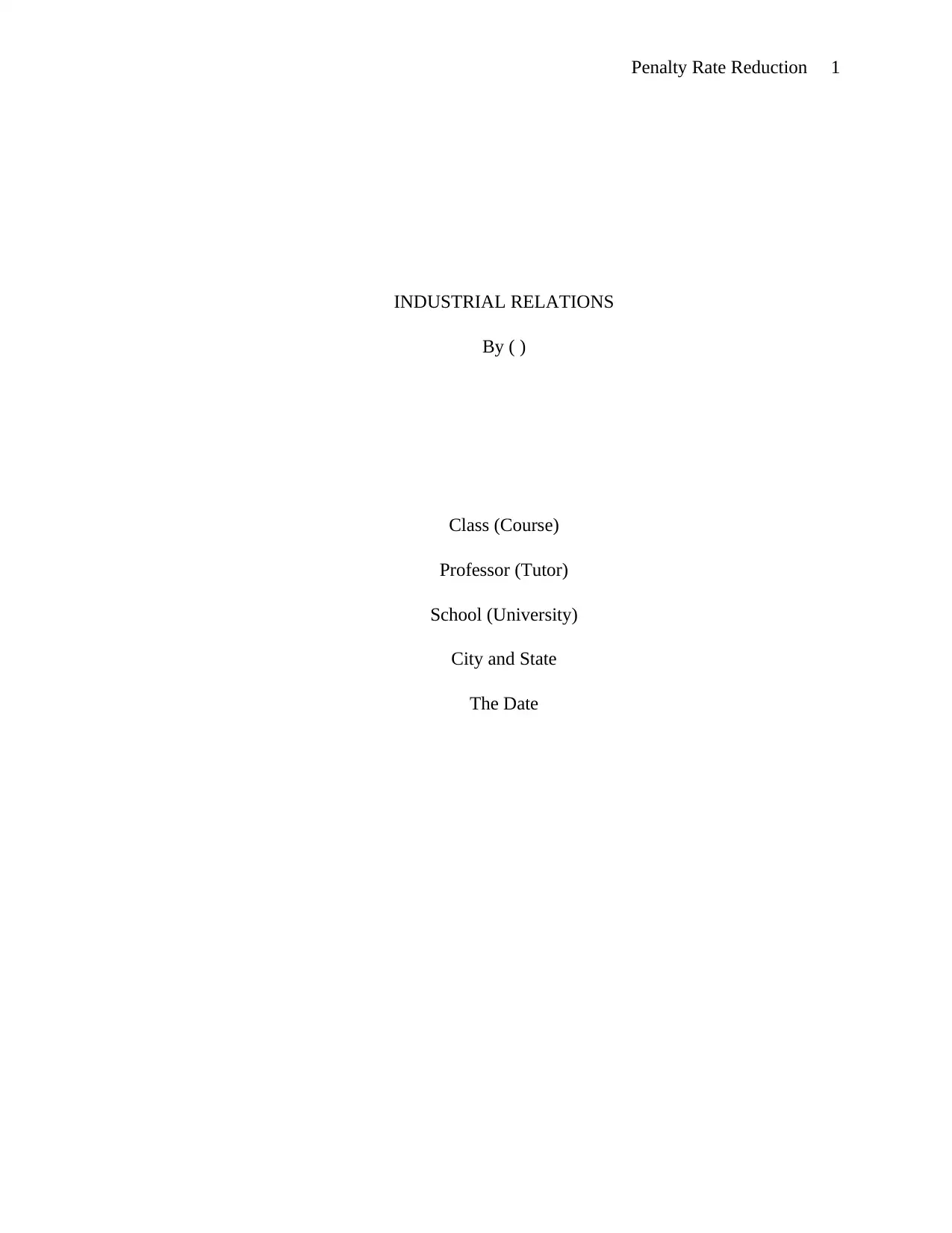
Penalty Rate Reduction 1
INDUSTRIAL RELATIONS
By ( )
Class (Course)
Professor (Tutor)
School (University)
City and State
The Date
INDUSTRIAL RELATIONS
By ( )
Class (Course)
Professor (Tutor)
School (University)
City and State
The Date
Paraphrase This Document
Need a fresh take? Get an instant paraphrase of this document with our AI Paraphraser

Penalty Rate Reduction 2
Introduction
In Australia, the three Industries; hospitality, fast food industries, and the retail do operate on
holidays and Sundays. The government, through the Council of Trade Unions of Australia
(CTUA), proposed a rule to impose a payment penalty on the industries that operate during
holidays. The council ruled that all workers of these industries who are approximately half a
million ranging from the country’s lowest paid to the highly- paid workers would be losing up to
$6, 000 in a year. Although the council stated that the cuts would serve to increase the trade
working hours and services during the Sundays and other public holidays, those changes were
going to cause some workers to experience hardship. In the year 2017, the Senate presented their
grievances to the Australian Fair Work Commission (FWC) requiring the penalties in both the
part-time and full-time workers to be reduced for the retail, fast food, and hospitality industries.
The matter was also referred to as the Education and Employment References committee for
discussion and evaluations. This was because the penalties that were imposed were not regulated
fairly in terms of the level of payments between the highly- paid employees of the large
industries and the low- paid workers from the small business employees. This paper is going to
analyze and discuss the main groups that were involved in the policy-making, and why it was
introduced, the essay further analyzes the impact of the concern parties from those who were
negatively affected or the disadvantaged to those who potentially benefited from the ruling. This
paper will also elaborate on the potential implications for both the employees and employers.
The Main Parties Involved in the Ruling
During the policy-making concerning the reduction of the imposed penalties on the workers,
there were many stakeholders involved. They include the senatorial committee, the secretariat of
major departments, the parliamentary committee involving working commission and penalties,
the Australian Fair Work Commission, the Employment and Education Reference Committee,
and the Australian Institute of Economics and Business (AIEB). The grievances in the bill were
referred to the parliament house for discussion, analyses, evaluation, and implementation. The
public opinions from the most affected people who were employed and the CEOs of the private
sectors were reviewed and used during evaluation. The ruling provoked a broad controversy
from different parties who were impacted and interested from the Unions of the Federal
Opposition to the employer's groups (Forsyth, 2016).
Introduction
In Australia, the three Industries; hospitality, fast food industries, and the retail do operate on
holidays and Sundays. The government, through the Council of Trade Unions of Australia
(CTUA), proposed a rule to impose a payment penalty on the industries that operate during
holidays. The council ruled that all workers of these industries who are approximately half a
million ranging from the country’s lowest paid to the highly- paid workers would be losing up to
$6, 000 in a year. Although the council stated that the cuts would serve to increase the trade
working hours and services during the Sundays and other public holidays, those changes were
going to cause some workers to experience hardship. In the year 2017, the Senate presented their
grievances to the Australian Fair Work Commission (FWC) requiring the penalties in both the
part-time and full-time workers to be reduced for the retail, fast food, and hospitality industries.
The matter was also referred to as the Education and Employment References committee for
discussion and evaluations. This was because the penalties that were imposed were not regulated
fairly in terms of the level of payments between the highly- paid employees of the large
industries and the low- paid workers from the small business employees. This paper is going to
analyze and discuss the main groups that were involved in the policy-making, and why it was
introduced, the essay further analyzes the impact of the concern parties from those who were
negatively affected or the disadvantaged to those who potentially benefited from the ruling. This
paper will also elaborate on the potential implications for both the employees and employers.
The Main Parties Involved in the Ruling
During the policy-making concerning the reduction of the imposed penalties on the workers,
there were many stakeholders involved. They include the senatorial committee, the secretariat of
major departments, the parliamentary committee involving working commission and penalties,
the Australian Fair Work Commission, the Employment and Education Reference Committee,
and the Australian Institute of Economics and Business (AIEB). The grievances in the bill were
referred to the parliament house for discussion, analyses, evaluation, and implementation. The
public opinions from the most affected people who were employed and the CEOs of the private
sectors were reviewed and used during evaluation. The ruling provoked a broad controversy
from different parties who were impacted and interested from the Unions of the Federal
Opposition to the employer's groups (Forsyth, 2016).

Penalty Rate Reduction 3
Why the ruling was introduced
The complaints about the penalties that were imposed on the wages were from the workers from
the following industries; hospitality, fast food industries, retail, pharmaceutical organizations,
and restaurants. The Senate committee claimed that the employees who work in large scale
businesses received low penalty rates as per their agreements with the enterprises during the
public holidays and weekends than the modem set awards which they receive on other days. This
gave the employers of large enterprises and competitive benefit over the employers with small
scale businesses which pay their employees the award rates. There was a desire to amend the
Fair Work Act of 2009 so that the businesses’ agreements do not involve term specifying the
penalty rates that are lower than the modem awards. The ruling was made to protect the Fair
Work Amendments Bill of 2017 and to solve any other penalty-related issues within the retail,
fast- food and hospitality sectors (Breheny, 2017).
In Australia, the penalty rates are a very crucial long-standing framework in workplace relations.
These penalties are considered as a compensation mechanism to the workers for they often miss
out their family’s interactions, social and other community’s event participation while working
as they build the economic sectors of the country (WORSE, 2017). Penalty rates are useful to
compensate for the time spent working, which should be spent as leisure time. These additional
working hours include; public holidays, weekends, early morning and late night shifts. These are
the time that could be spent by the working individual to interact with their children, relatives,
community events, resting or participating in sports activities. It is quite true that the penalty
rates give the financial reimbursement measure for the sacrificed leisure time, which is spent at
work (Bryan, and Rafferty, 2018).
There are some people who prefer to work on public holiday, weekend and nights because the
pay rate at these periods is very high. These are mostly the employees who work in the
hospitality, retail, and fast food industries. These groups of workers are the ones who mostly face
financial stress and rely on the penalty rates to cater for their living expenses. These were some
of the consideration by the Fair Work commission while making the ruling on penalty rate
reduction. The employees from the three enterprises earn very little, that is, they just earn enough
as they spent and thus have difficulties in saving money or to handle unexpected expenses.
Therefore they considerably face much financial distress. The implementation of the ruling by
Why the ruling was introduced
The complaints about the penalties that were imposed on the wages were from the workers from
the following industries; hospitality, fast food industries, retail, pharmaceutical organizations,
and restaurants. The Senate committee claimed that the employees who work in large scale
businesses received low penalty rates as per their agreements with the enterprises during the
public holidays and weekends than the modem set awards which they receive on other days. This
gave the employers of large enterprises and competitive benefit over the employers with small
scale businesses which pay their employees the award rates. There was a desire to amend the
Fair Work Act of 2009 so that the businesses’ agreements do not involve term specifying the
penalty rates that are lower than the modem awards. The ruling was made to protect the Fair
Work Amendments Bill of 2017 and to solve any other penalty-related issues within the retail,
fast- food and hospitality sectors (Breheny, 2017).
In Australia, the penalty rates are a very crucial long-standing framework in workplace relations.
These penalties are considered as a compensation mechanism to the workers for they often miss
out their family’s interactions, social and other community’s event participation while working
as they build the economic sectors of the country (WORSE, 2017). Penalty rates are useful to
compensate for the time spent working, which should be spent as leisure time. These additional
working hours include; public holidays, weekends, early morning and late night shifts. These are
the time that could be spent by the working individual to interact with their children, relatives,
community events, resting or participating in sports activities. It is quite true that the penalty
rates give the financial reimbursement measure for the sacrificed leisure time, which is spent at
work (Bryan, and Rafferty, 2018).
There are some people who prefer to work on public holiday, weekend and nights because the
pay rate at these periods is very high. These are mostly the employees who work in the
hospitality, retail, and fast food industries. These groups of workers are the ones who mostly face
financial stress and rely on the penalty rates to cater for their living expenses. These were some
of the consideration by the Fair Work commission while making the ruling on penalty rate
reduction. The employees from the three enterprises earn very little, that is, they just earn enough
as they spent and thus have difficulties in saving money or to handle unexpected expenses.
Therefore they considerably face much financial distress. The implementation of the ruling by
⊘ This is a preview!⊘
Do you want full access?
Subscribe today to unlock all pages.

Trusted by 1+ million students worldwide
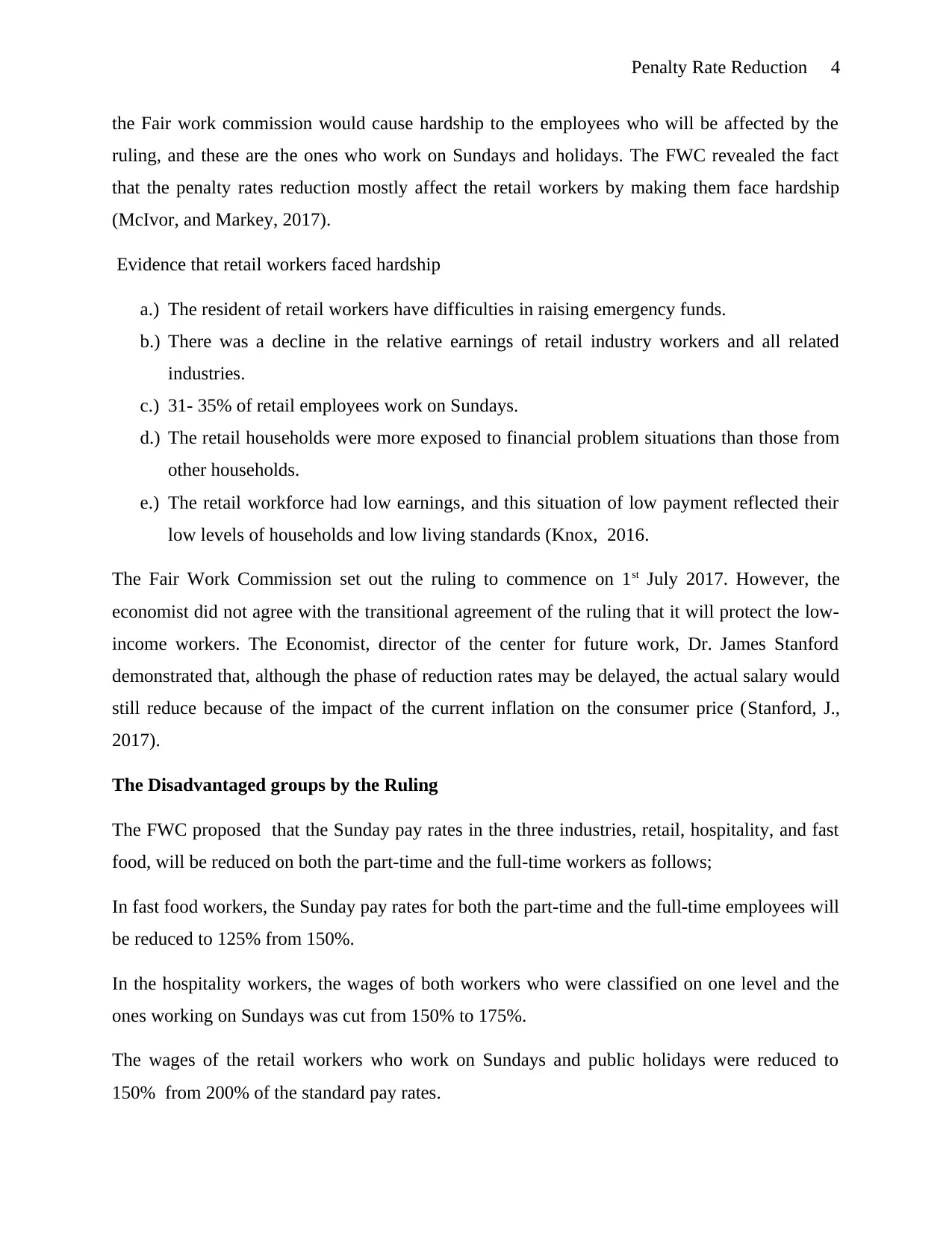
Penalty Rate Reduction 4
the Fair work commission would cause hardship to the employees who will be affected by the
ruling, and these are the ones who work on Sundays and holidays. The FWC revealed the fact
that the penalty rates reduction mostly affect the retail workers by making them face hardship
(McIvor, and Markey, 2017).
Evidence that retail workers faced hardship
a.) The resident of retail workers have difficulties in raising emergency funds.
b.) There was a decline in the relative earnings of retail industry workers and all related
industries.
c.) 31- 35% of retail employees work on Sundays.
d.) The retail households were more exposed to financial problem situations than those from
other households.
e.) The retail workforce had low earnings, and this situation of low payment reflected their
low levels of households and low living standards (Knox, 2016.
The Fair Work Commission set out the ruling to commence on 1st July 2017. However, the
economist did not agree with the transitional agreement of the ruling that it will protect the low-
income workers. The Economist, director of the center for future work, Dr. James Stanford
demonstrated that, although the phase of reduction rates may be delayed, the actual salary would
still reduce because of the impact of the current inflation on the consumer price (Stanford, J.,
2017).
The Disadvantaged groups by the Ruling
The FWC proposed that the Sunday pay rates in the three industries, retail, hospitality, and fast
food, will be reduced on both the part-time and the full-time workers as follows;
In fast food workers, the Sunday pay rates for both the part-time and the full-time employees will
be reduced to 125% from 150%.
In the hospitality workers, the wages of both workers who were classified on one level and the
ones working on Sundays was cut from 150% to 175%.
The wages of the retail workers who work on Sundays and public holidays were reduced to
150% from 200% of the standard pay rates.
the Fair work commission would cause hardship to the employees who will be affected by the
ruling, and these are the ones who work on Sundays and holidays. The FWC revealed the fact
that the penalty rates reduction mostly affect the retail workers by making them face hardship
(McIvor, and Markey, 2017).
Evidence that retail workers faced hardship
a.) The resident of retail workers have difficulties in raising emergency funds.
b.) There was a decline in the relative earnings of retail industry workers and all related
industries.
c.) 31- 35% of retail employees work on Sundays.
d.) The retail households were more exposed to financial problem situations than those from
other households.
e.) The retail workforce had low earnings, and this situation of low payment reflected their
low levels of households and low living standards (Knox, 2016.
The Fair Work Commission set out the ruling to commence on 1st July 2017. However, the
economist did not agree with the transitional agreement of the ruling that it will protect the low-
income workers. The Economist, director of the center for future work, Dr. James Stanford
demonstrated that, although the phase of reduction rates may be delayed, the actual salary would
still reduce because of the impact of the current inflation on the consumer price (Stanford, J.,
2017).
The Disadvantaged groups by the Ruling
The FWC proposed that the Sunday pay rates in the three industries, retail, hospitality, and fast
food, will be reduced on both the part-time and the full-time workers as follows;
In fast food workers, the Sunday pay rates for both the part-time and the full-time employees will
be reduced to 125% from 150%.
In the hospitality workers, the wages of both workers who were classified on one level and the
ones working on Sundays was cut from 150% to 175%.
The wages of the retail workers who work on Sundays and public holidays were reduced to
150% from 200% of the standard pay rates.
Paraphrase This Document
Need a fresh take? Get an instant paraphrase of this document with our AI Paraphraser
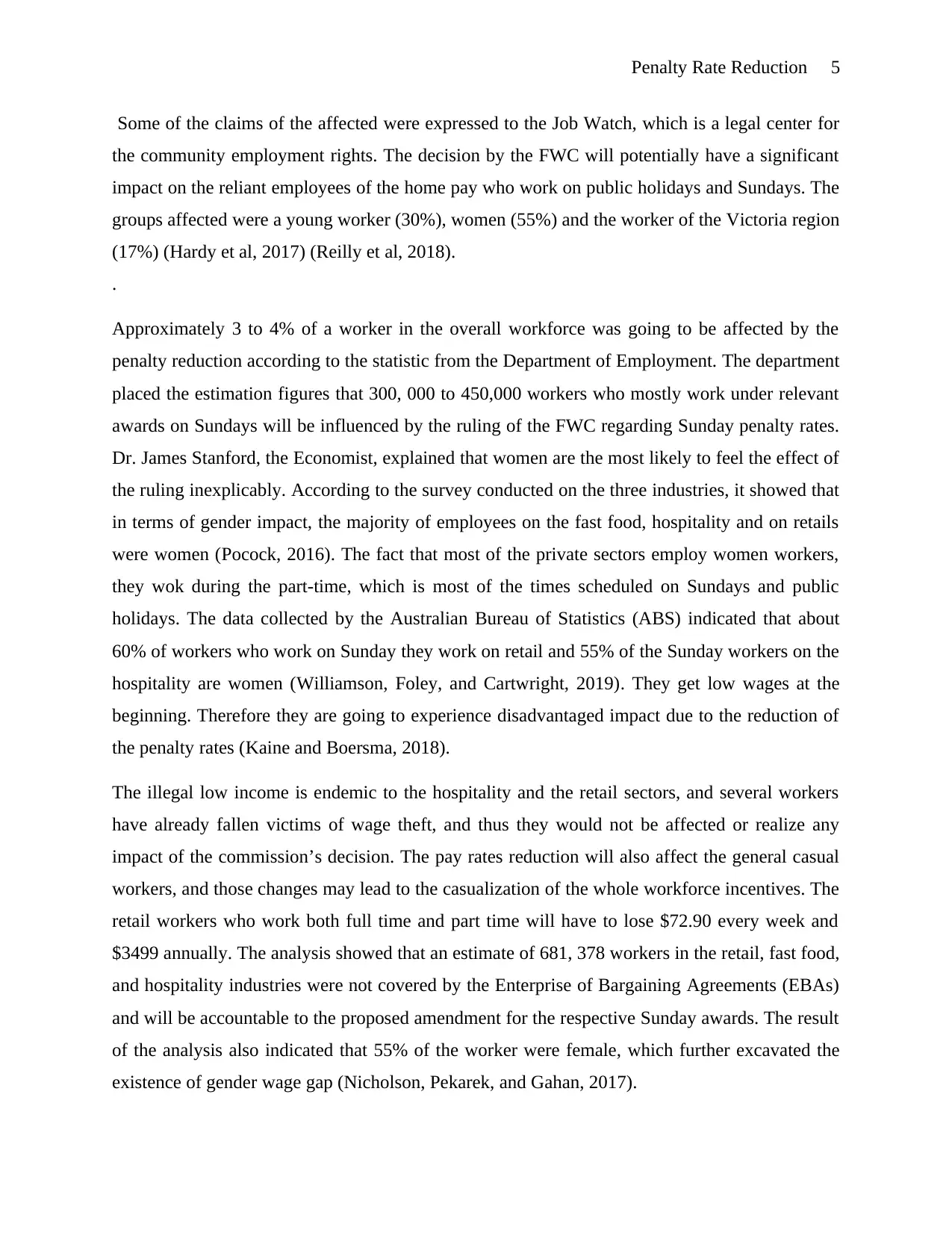
Penalty Rate Reduction 5
Some of the claims of the affected were expressed to the Job Watch, which is a legal center for
the community employment rights. The decision by the FWC will potentially have a significant
impact on the reliant employees of the home pay who work on public holidays and Sundays. The
groups affected were a young worker (30%), women (55%) and the worker of the Victoria region
(17%) (Hardy et al, 2017) (Reilly et al, 2018).
.
Approximately 3 to 4% of a worker in the overall workforce was going to be affected by the
penalty reduction according to the statistic from the Department of Employment. The department
placed the estimation figures that 300, 000 to 450,000 workers who mostly work under relevant
awards on Sundays will be influenced by the ruling of the FWC regarding Sunday penalty rates.
Dr. James Stanford, the Economist, explained that women are the most likely to feel the effect of
the ruling inexplicably. According to the survey conducted on the three industries, it showed that
in terms of gender impact, the majority of employees on the fast food, hospitality and on retails
were women (Pocock, 2016). The fact that most of the private sectors employ women workers,
they wok during the part-time, which is most of the times scheduled on Sundays and public
holidays. The data collected by the Australian Bureau of Statistics (ABS) indicated that about
60% of workers who work on Sunday they work on retail and 55% of the Sunday workers on the
hospitality are women (Williamson, Foley, and Cartwright, 2019). They get low wages at the
beginning. Therefore they are going to experience disadvantaged impact due to the reduction of
the penalty rates (Kaine and Boersma, 2018).
The illegal low income is endemic to the hospitality and the retail sectors, and several workers
have already fallen victims of wage theft, and thus they would not be affected or realize any
impact of the commission’s decision. The pay rates reduction will also affect the general casual
workers, and those changes may lead to the casualization of the whole workforce incentives. The
retail workers who work both full time and part time will have to lose $72.90 every week and
$3499 annually. The analysis showed that an estimate of 681, 378 workers in the retail, fast food,
and hospitality industries were not covered by the Enterprise of Bargaining Agreements (EBAs)
and will be accountable to the proposed amendment for the respective Sunday awards. The result
of the analysis also indicated that 55% of the worker were female, which further excavated the
existence of gender wage gap (Nicholson, Pekarek, and Gahan, 2017).
Some of the claims of the affected were expressed to the Job Watch, which is a legal center for
the community employment rights. The decision by the FWC will potentially have a significant
impact on the reliant employees of the home pay who work on public holidays and Sundays. The
groups affected were a young worker (30%), women (55%) and the worker of the Victoria region
(17%) (Hardy et al, 2017) (Reilly et al, 2018).
.
Approximately 3 to 4% of a worker in the overall workforce was going to be affected by the
penalty reduction according to the statistic from the Department of Employment. The department
placed the estimation figures that 300, 000 to 450,000 workers who mostly work under relevant
awards on Sundays will be influenced by the ruling of the FWC regarding Sunday penalty rates.
Dr. James Stanford, the Economist, explained that women are the most likely to feel the effect of
the ruling inexplicably. According to the survey conducted on the three industries, it showed that
in terms of gender impact, the majority of employees on the fast food, hospitality and on retails
were women (Pocock, 2016). The fact that most of the private sectors employ women workers,
they wok during the part-time, which is most of the times scheduled on Sundays and public
holidays. The data collected by the Australian Bureau of Statistics (ABS) indicated that about
60% of workers who work on Sunday they work on retail and 55% of the Sunday workers on the
hospitality are women (Williamson, Foley, and Cartwright, 2019). They get low wages at the
beginning. Therefore they are going to experience disadvantaged impact due to the reduction of
the penalty rates (Kaine and Boersma, 2018).
The illegal low income is endemic to the hospitality and the retail sectors, and several workers
have already fallen victims of wage theft, and thus they would not be affected or realize any
impact of the commission’s decision. The pay rates reduction will also affect the general casual
workers, and those changes may lead to the casualization of the whole workforce incentives. The
retail workers who work both full time and part time will have to lose $72.90 every week and
$3499 annually. The analysis showed that an estimate of 681, 378 workers in the retail, fast food,
and hospitality industries were not covered by the Enterprise of Bargaining Agreements (EBAs)
and will be accountable to the proposed amendment for the respective Sunday awards. The result
of the analysis also indicated that 55% of the worker were female, which further excavated the
existence of gender wage gap (Nicholson, Pekarek, and Gahan, 2017).

Penalty Rate Reduction 6
The part-time and the full-time retail workers working at 8- hours on Sundays are liable to the
pay rates changes for their holiday awards and that they are the most affected by the ruling
because of at least $ 72.9% cuts on their Sunday payments. Most of the low-income earners rely
on Sunday shift working hours to boost their living standards. It should be noted that the
reduction of the Sunday remuneration for both the casual workers, part-time employees (PTEs),
and the full-time employees (FTEs) was mostly negatively impacted in both retail and hospitality
industries. The casual workers will notice no impact on the pay rate reduction while the PTSs
and the FTEs will have a reduction of the pay rate of $33.9 on the usual extra time payments
(Pekarek, and Gahan, 2016). The same case applies to the retail workers, whereby they will be
adversely affected due to the proposed changes.
In the fast food workers, the situation is vice verse whereby the PTEs and the FTEs will have the
Sunday payment reduced $36.45, and the respective casual workers will lose $45.56 for the eight
hours of the Sunday shift. The three industries mostly employ several casual and part-time
workers, and many of them are the new parents who return to the workforce and breaks and the
tertiary students. In the wages of these workers, there are disproportional percentages on their
weekend shifts on weekly and annual earnings. Many of the student work during the weekends
only and the reduction affects them directly, hence negatively (Campbell, Boese, and Tham,
2016).
The Advantaged by the Ruling
The consumers are going to benefits from the ruling such that when the FWC reduces the pay
rates because of the long working hours in the three industries and therefore the shops, clubs and
the fast food enterprises will be opened for a long time. It advantaged to the consumers because
they will be able to shop throughout hours that they could not shop previously before the reform
could enhance long opening hours in these businesses. The reduction of the Sundays pay rates by
the FWC will increase the value interest to the consumers, low capital utilization, and product
diversity because there will be more services due to long working hours. The long working hours
will, therefore, effect to high aggregates of transaction quantities. The penalty cuts will lead to
more profits on the small business because the input cost on the workforce will be decreased.
Productivity in the businesses would be enhanced because these industries will advertise
The part-time and the full-time retail workers working at 8- hours on Sundays are liable to the
pay rates changes for their holiday awards and that they are the most affected by the ruling
because of at least $ 72.9% cuts on their Sunday payments. Most of the low-income earners rely
on Sunday shift working hours to boost their living standards. It should be noted that the
reduction of the Sunday remuneration for both the casual workers, part-time employees (PTEs),
and the full-time employees (FTEs) was mostly negatively impacted in both retail and hospitality
industries. The casual workers will notice no impact on the pay rate reduction while the PTSs
and the FTEs will have a reduction of the pay rate of $33.9 on the usual extra time payments
(Pekarek, and Gahan, 2016). The same case applies to the retail workers, whereby they will be
adversely affected due to the proposed changes.
In the fast food workers, the situation is vice verse whereby the PTEs and the FTEs will have the
Sunday payment reduced $36.45, and the respective casual workers will lose $45.56 for the eight
hours of the Sunday shift. The three industries mostly employ several casual and part-time
workers, and many of them are the new parents who return to the workforce and breaks and the
tertiary students. In the wages of these workers, there are disproportional percentages on their
weekend shifts on weekly and annual earnings. Many of the student work during the weekends
only and the reduction affects them directly, hence negatively (Campbell, Boese, and Tham,
2016).
The Advantaged by the Ruling
The consumers are going to benefits from the ruling such that when the FWC reduces the pay
rates because of the long working hours in the three industries and therefore the shops, clubs and
the fast food enterprises will be opened for a long time. It advantaged to the consumers because
they will be able to shop throughout hours that they could not shop previously before the reform
could enhance long opening hours in these businesses. The reduction of the Sundays pay rates by
the FWC will increase the value interest to the consumers, low capital utilization, and product
diversity because there will be more services due to long working hours. The long working hours
will, therefore, effect to high aggregates of transaction quantities. The penalty cuts will lead to
more profits on the small business because the input cost on the workforce will be decreased.
Productivity in the businesses would be enhanced because these industries will advertise
⊘ This is a preview!⊘
Do you want full access?
Subscribe today to unlock all pages.

Trusted by 1+ million students worldwide
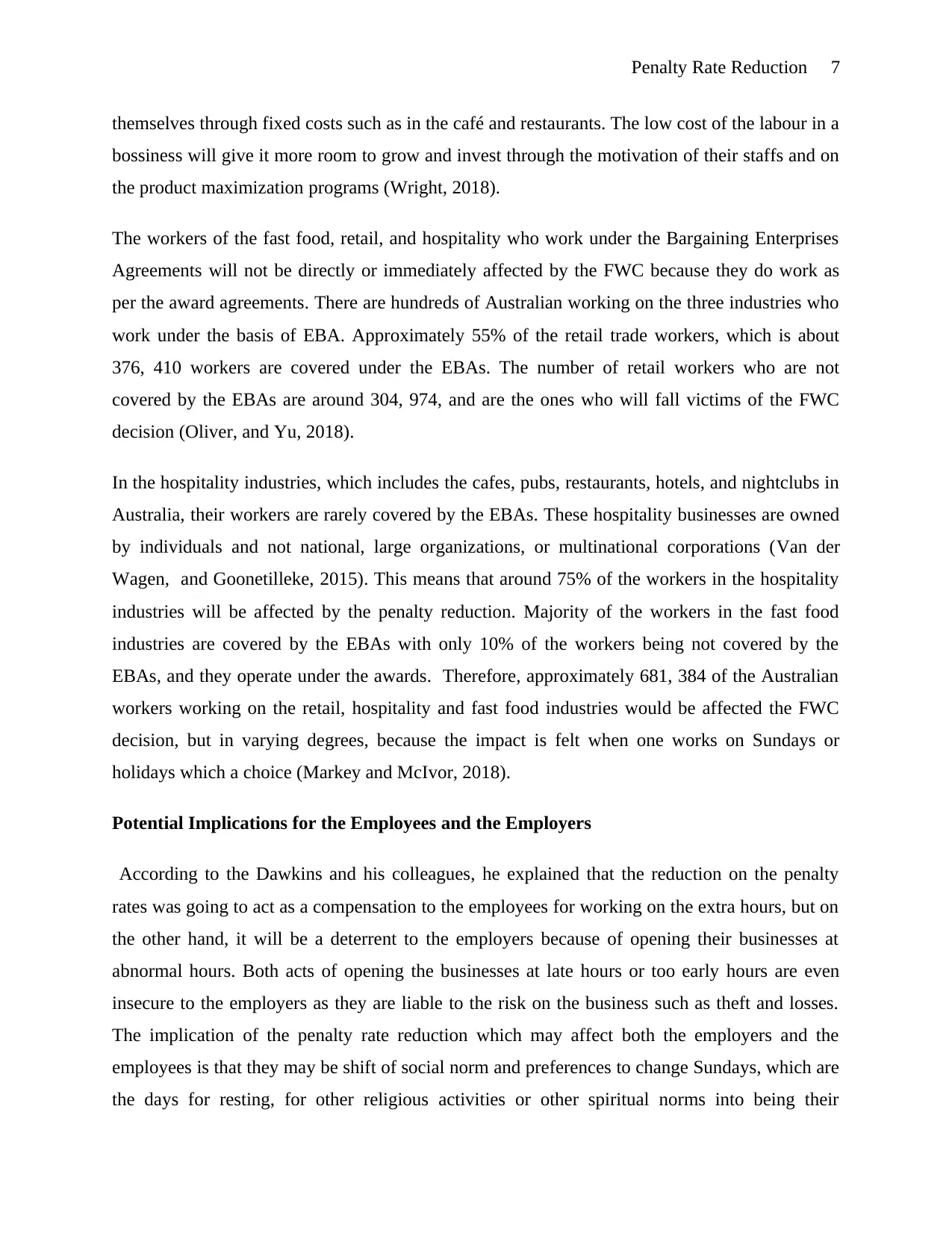
Penalty Rate Reduction 7
themselves through fixed costs such as in the café and restaurants. The low cost of the labour in a
bossiness will give it more room to grow and invest through the motivation of their staffs and on
the product maximization programs (Wright, 2018).
The workers of the fast food, retail, and hospitality who work under the Bargaining Enterprises
Agreements will not be directly or immediately affected by the FWC because they do work as
per the award agreements. There are hundreds of Australian working on the three industries who
work under the basis of EBA. Approximately 55% of the retail trade workers, which is about
376, 410 workers are covered under the EBAs. The number of retail workers who are not
covered by the EBAs are around 304, 974, and are the ones who will fall victims of the FWC
decision (Oliver, and Yu, 2018).
In the hospitality industries, which includes the cafes, pubs, restaurants, hotels, and nightclubs in
Australia, their workers are rarely covered by the EBAs. These hospitality businesses are owned
by individuals and not national, large organizations, or multinational corporations (Van der
Wagen, and Goonetilleke, 2015). This means that around 75% of the workers in the hospitality
industries will be affected by the penalty reduction. Majority of the workers in the fast food
industries are covered by the EBAs with only 10% of the workers being not covered by the
EBAs, and they operate under the awards. Therefore, approximately 681, 384 of the Australian
workers working on the retail, hospitality and fast food industries would be affected the FWC
decision, but in varying degrees, because the impact is felt when one works on Sundays or
holidays which a choice (Markey and McIvor, 2018).
Potential Implications for the Employees and the Employers
According to the Dawkins and his colleagues, he explained that the reduction on the penalty
rates was going to act as a compensation to the employees for working on the extra hours, but on
the other hand, it will be a deterrent to the employers because of opening their businesses at
abnormal hours. Both acts of opening the businesses at late hours or too early hours are even
insecure to the employers as they are liable to the risk on the business such as theft and losses.
The implication of the penalty rate reduction which may affect both the employers and the
employees is that they may be shift of social norm and preferences to change Sundays, which are
the days for resting, for other religious activities or other spiritual norms into being their
themselves through fixed costs such as in the café and restaurants. The low cost of the labour in a
bossiness will give it more room to grow and invest through the motivation of their staffs and on
the product maximization programs (Wright, 2018).
The workers of the fast food, retail, and hospitality who work under the Bargaining Enterprises
Agreements will not be directly or immediately affected by the FWC because they do work as
per the award agreements. There are hundreds of Australian working on the three industries who
work under the basis of EBA. Approximately 55% of the retail trade workers, which is about
376, 410 workers are covered under the EBAs. The number of retail workers who are not
covered by the EBAs are around 304, 974, and are the ones who will fall victims of the FWC
decision (Oliver, and Yu, 2018).
In the hospitality industries, which includes the cafes, pubs, restaurants, hotels, and nightclubs in
Australia, their workers are rarely covered by the EBAs. These hospitality businesses are owned
by individuals and not national, large organizations, or multinational corporations (Van der
Wagen, and Goonetilleke, 2015). This means that around 75% of the workers in the hospitality
industries will be affected by the penalty reduction. Majority of the workers in the fast food
industries are covered by the EBAs with only 10% of the workers being not covered by the
EBAs, and they operate under the awards. Therefore, approximately 681, 384 of the Australian
workers working on the retail, hospitality and fast food industries would be affected the FWC
decision, but in varying degrees, because the impact is felt when one works on Sundays or
holidays which a choice (Markey and McIvor, 2018).
Potential Implications for the Employees and the Employers
According to the Dawkins and his colleagues, he explained that the reduction on the penalty
rates was going to act as a compensation to the employees for working on the extra hours, but on
the other hand, it will be a deterrent to the employers because of opening their businesses at
abnormal hours. Both acts of opening the businesses at late hours or too early hours are even
insecure to the employers as they are liable to the risk on the business such as theft and losses.
The implication of the penalty rate reduction which may affect both the employers and the
employees is that they may be shift of social norm and preferences to change Sundays, which are
the days for resting, for other religious activities or other spiritual norms into being their
Paraphrase This Document
Need a fresh take? Get an instant paraphrase of this document with our AI Paraphraser
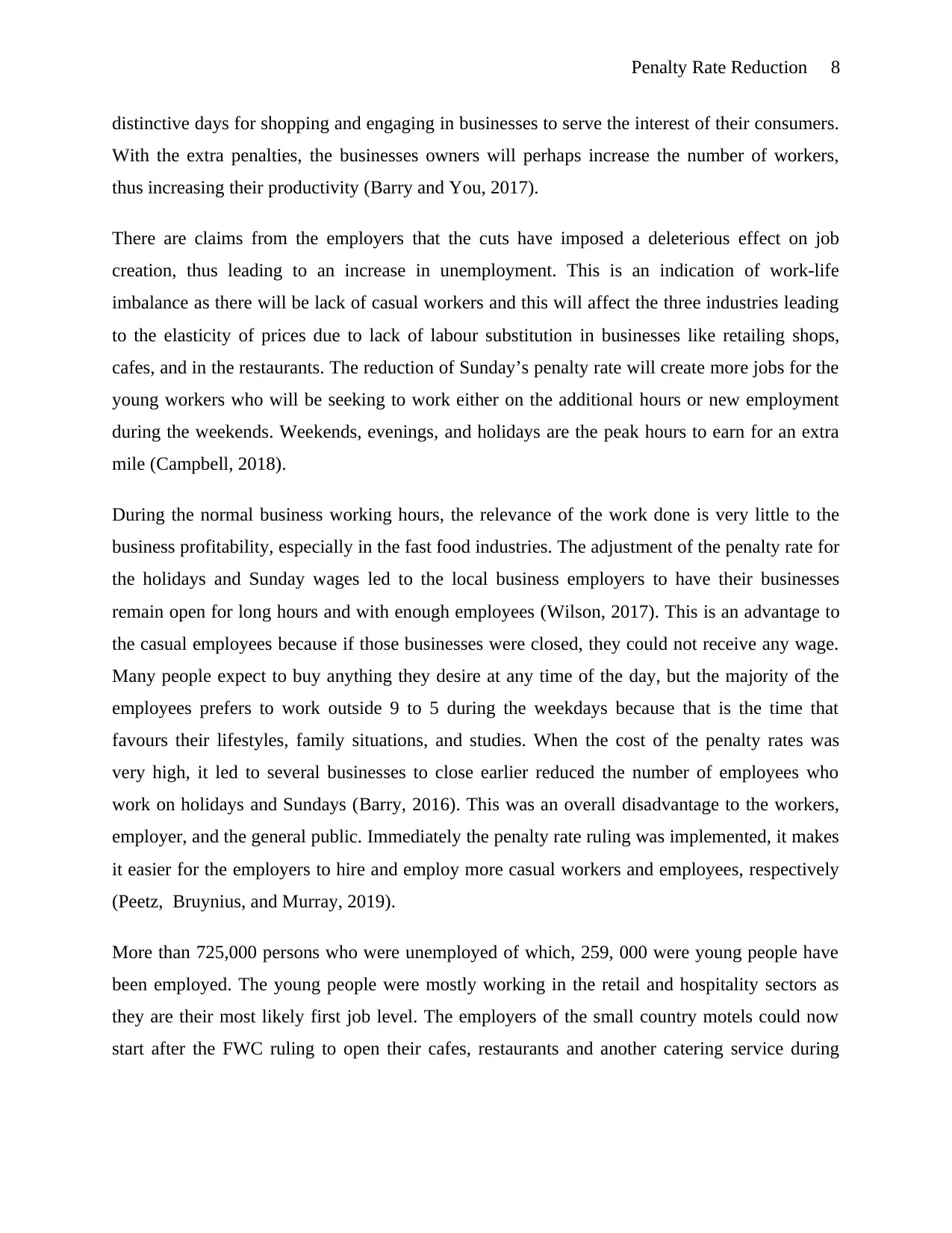
Penalty Rate Reduction 8
distinctive days for shopping and engaging in businesses to serve the interest of their consumers.
With the extra penalties, the businesses owners will perhaps increase the number of workers,
thus increasing their productivity (Barry and You, 2017).
There are claims from the employers that the cuts have imposed a deleterious effect on job
creation, thus leading to an increase in unemployment. This is an indication of work-life
imbalance as there will be lack of casual workers and this will affect the three industries leading
to the elasticity of prices due to lack of labour substitution in businesses like retailing shops,
cafes, and in the restaurants. The reduction of Sunday’s penalty rate will create more jobs for the
young workers who will be seeking to work either on the additional hours or new employment
during the weekends. Weekends, evenings, and holidays are the peak hours to earn for an extra
mile (Campbell, 2018).
During the normal business working hours, the relevance of the work done is very little to the
business profitability, especially in the fast food industries. The adjustment of the penalty rate for
the holidays and Sunday wages led to the local business employers to have their businesses
remain open for long hours and with enough employees (Wilson, 2017). This is an advantage to
the casual employees because if those businesses were closed, they could not receive any wage.
Many people expect to buy anything they desire at any time of the day, but the majority of the
employees prefers to work outside 9 to 5 during the weekdays because that is the time that
favours their lifestyles, family situations, and studies. When the cost of the penalty rates was
very high, it led to several businesses to close earlier reduced the number of employees who
work on holidays and Sundays (Barry, 2016). This was an overall disadvantage to the workers,
employer, and the general public. Immediately the penalty rate ruling was implemented, it makes
it easier for the employers to hire and employ more casual workers and employees, respectively
(Peetz, Bruynius, and Murray, 2019).
More than 725,000 persons who were unemployed of which, 259, 000 were young people have
been employed. The young people were mostly working in the retail and hospitality sectors as
they are their most likely first job level. The employers of the small country motels could now
start after the FWC ruling to open their cafes, restaurants and another catering service during
distinctive days for shopping and engaging in businesses to serve the interest of their consumers.
With the extra penalties, the businesses owners will perhaps increase the number of workers,
thus increasing their productivity (Barry and You, 2017).
There are claims from the employers that the cuts have imposed a deleterious effect on job
creation, thus leading to an increase in unemployment. This is an indication of work-life
imbalance as there will be lack of casual workers and this will affect the three industries leading
to the elasticity of prices due to lack of labour substitution in businesses like retailing shops,
cafes, and in the restaurants. The reduction of Sunday’s penalty rate will create more jobs for the
young workers who will be seeking to work either on the additional hours or new employment
during the weekends. Weekends, evenings, and holidays are the peak hours to earn for an extra
mile (Campbell, 2018).
During the normal business working hours, the relevance of the work done is very little to the
business profitability, especially in the fast food industries. The adjustment of the penalty rate for
the holidays and Sunday wages led to the local business employers to have their businesses
remain open for long hours and with enough employees (Wilson, 2017). This is an advantage to
the casual employees because if those businesses were closed, they could not receive any wage.
Many people expect to buy anything they desire at any time of the day, but the majority of the
employees prefers to work outside 9 to 5 during the weekdays because that is the time that
favours their lifestyles, family situations, and studies. When the cost of the penalty rates was
very high, it led to several businesses to close earlier reduced the number of employees who
work on holidays and Sundays (Barry, 2016). This was an overall disadvantage to the workers,
employer, and the general public. Immediately the penalty rate ruling was implemented, it makes
it easier for the employers to hire and employ more casual workers and employees, respectively
(Peetz, Bruynius, and Murray, 2019).
More than 725,000 persons who were unemployed of which, 259, 000 were young people have
been employed. The young people were mostly working in the retail and hospitality sectors as
they are their most likely first job level. The employers of the small country motels could now
start after the FWC ruling to open their cafes, restaurants and another catering service during
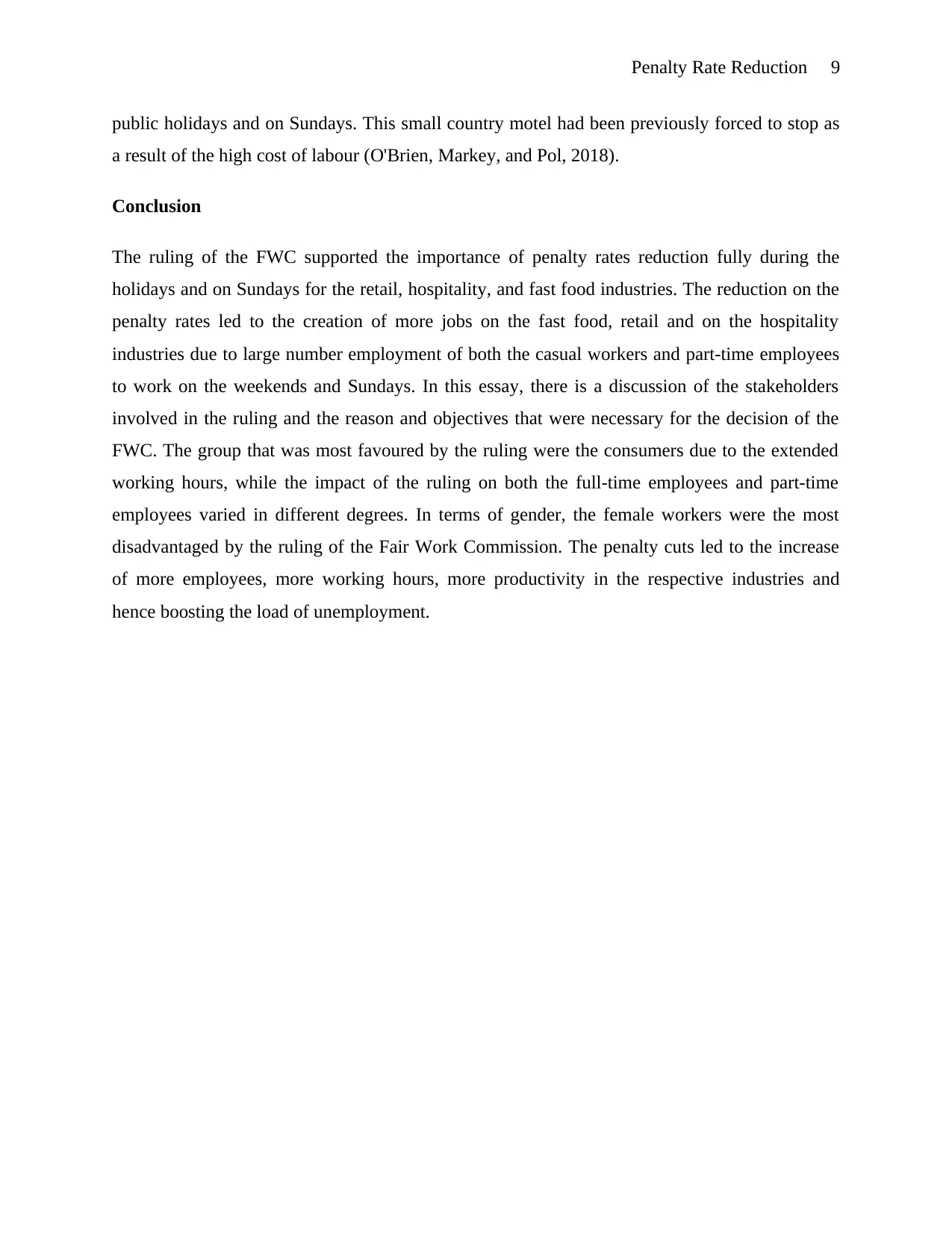
Penalty Rate Reduction 9
public holidays and on Sundays. This small country motel had been previously forced to stop as
a result of the high cost of labour (O'Brien, Markey, and Pol, 2018).
Conclusion
The ruling of the FWC supported the importance of penalty rates reduction fully during the
holidays and on Sundays for the retail, hospitality, and fast food industries. The reduction on the
penalty rates led to the creation of more jobs on the fast food, retail and on the hospitality
industries due to large number employment of both the casual workers and part-time employees
to work on the weekends and Sundays. In this essay, there is a discussion of the stakeholders
involved in the ruling and the reason and objectives that were necessary for the decision of the
FWC. The group that was most favoured by the ruling were the consumers due to the extended
working hours, while the impact of the ruling on both the full-time employees and part-time
employees varied in different degrees. In terms of gender, the female workers were the most
disadvantaged by the ruling of the Fair Work Commission. The penalty cuts led to the increase
of more employees, more working hours, more productivity in the respective industries and
hence boosting the load of unemployment.
public holidays and on Sundays. This small country motel had been previously forced to stop as
a result of the high cost of labour (O'Brien, Markey, and Pol, 2018).
Conclusion
The ruling of the FWC supported the importance of penalty rates reduction fully during the
holidays and on Sundays for the retail, hospitality, and fast food industries. The reduction on the
penalty rates led to the creation of more jobs on the fast food, retail and on the hospitality
industries due to large number employment of both the casual workers and part-time employees
to work on the weekends and Sundays. In this essay, there is a discussion of the stakeholders
involved in the ruling and the reason and objectives that were necessary for the decision of the
FWC. The group that was most favoured by the ruling were the consumers due to the extended
working hours, while the impact of the ruling on both the full-time employees and part-time
employees varied in different degrees. In terms of gender, the female workers were the most
disadvantaged by the ruling of the Fair Work Commission. The penalty cuts led to the increase
of more employees, more working hours, more productivity in the respective industries and
hence boosting the load of unemployment.
⊘ This is a preview!⊘
Do you want full access?
Subscribe today to unlock all pages.

Trusted by 1+ million students worldwide

Penalty Rate Reduction 10
Reference
Barry, M., 2016. Employer and employer association matters in Australia in 2015. Journal of
Industrial Relations, 58(3), pp.340-355.
Barry, M. and You, K., 2017. Employer and employer association matters in Australia in 2016.
Journal of Industrial Relations, 59(3), pp.288-304.
Breheny, S., 2017. Penalising the unemployed. Institute of Public Affairs Review: A Quarterly
Review of Politics and Public Affairs, The, 69(2), p.20.
Bryan, D. and Rafferty, M., 2018. Risking together: How finance is dominating everyday life in
Australia. Sydney University Press.
Campbell, I., 2018. On-call and related forms of casual work in New Zealand and Australia.
International Labour Organization, Geneva.[Google Scholar].
Campbell, I., Boese, M. and Tham, J.C., 2016. Inhospitable workplaces? International students
and paid work in food services. Australian Journal of Social Issues, 51(3), pp.279-298.
Forsyth, A., 2016. Industrial legislation in Australia in 2015. Journal of Industrial Relations,
58(3), pp.372-387.
Hardy, Tess, and John Howe. "Creating Ripples, Making Waves: Assessing the General
Deterrence Effects of Enforcement Activities of the Fair Work Ombudsman." Sydney L. Rev. 39
(2017): 471.
Kaine, S. and Boersma, M., 2018. Women, work and industrial relations in Australia in 2017.
Journal of Industrial Relations, 60(3), pp.317-336.
Knox, A., 2016. The temporary agency work industry and its regulatory environment: evidence
from Australia. In Temporary Agency Work and Globalisation (pp. 117-148). Routledge.
Reference
Barry, M., 2016. Employer and employer association matters in Australia in 2015. Journal of
Industrial Relations, 58(3), pp.340-355.
Barry, M. and You, K., 2017. Employer and employer association matters in Australia in 2016.
Journal of Industrial Relations, 59(3), pp.288-304.
Breheny, S., 2017. Penalising the unemployed. Institute of Public Affairs Review: A Quarterly
Review of Politics and Public Affairs, The, 69(2), p.20.
Bryan, D. and Rafferty, M., 2018. Risking together: How finance is dominating everyday life in
Australia. Sydney University Press.
Campbell, I., 2018. On-call and related forms of casual work in New Zealand and Australia.
International Labour Organization, Geneva.[Google Scholar].
Campbell, I., Boese, M. and Tham, J.C., 2016. Inhospitable workplaces? International students
and paid work in food services. Australian Journal of Social Issues, 51(3), pp.279-298.
Forsyth, A., 2016. Industrial legislation in Australia in 2015. Journal of Industrial Relations,
58(3), pp.372-387.
Hardy, Tess, and John Howe. "Creating Ripples, Making Waves: Assessing the General
Deterrence Effects of Enforcement Activities of the Fair Work Ombudsman." Sydney L. Rev. 39
(2017): 471.
Kaine, S. and Boersma, M., 2018. Women, work and industrial relations in Australia in 2017.
Journal of Industrial Relations, 60(3), pp.317-336.
Knox, A., 2016. The temporary agency work industry and its regulatory environment: evidence
from Australia. In Temporary Agency Work and Globalisation (pp. 117-148). Routledge.
Paraphrase This Document
Need a fresh take? Get an instant paraphrase of this document with our AI Paraphraser
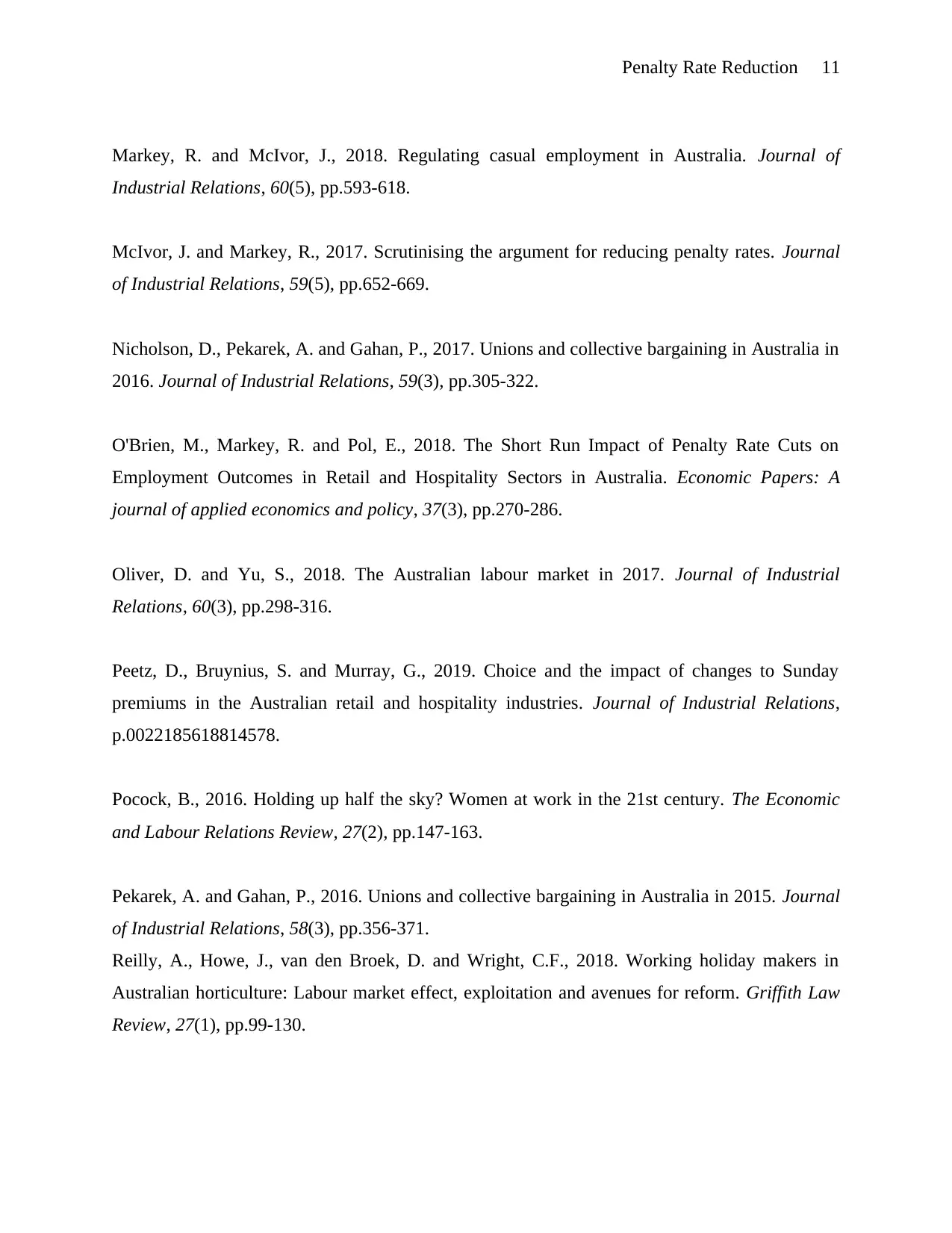
Penalty Rate Reduction 11
Markey, R. and McIvor, J., 2018. Regulating casual employment in Australia. Journal of
Industrial Relations, 60(5), pp.593-618.
McIvor, J. and Markey, R., 2017. Scrutinising the argument for reducing penalty rates. Journal
of Industrial Relations, 59(5), pp.652-669.
Nicholson, D., Pekarek, A. and Gahan, P., 2017. Unions and collective bargaining in Australia in
2016. Journal of Industrial Relations, 59(3), pp.305-322.
O'Brien, M., Markey, R. and Pol, E., 2018. The Short Run Impact of Penalty Rate Cuts on
Employment Outcomes in Retail and Hospitality Sectors in Australia. Economic Papers: A
journal of applied economics and policy, 37(3), pp.270-286.
Oliver, D. and Yu, S., 2018. The Australian labour market in 2017. Journal of Industrial
Relations, 60(3), pp.298-316.
Peetz, D., Bruynius, S. and Murray, G., 2019. Choice and the impact of changes to Sunday
premiums in the Australian retail and hospitality industries. Journal of Industrial Relations,
p.0022185618814578.
Pocock, B., 2016. Holding up half the sky? Women at work in the 21st century. The Economic
and Labour Relations Review, 27(2), pp.147-163.
Pekarek, A. and Gahan, P., 2016. Unions and collective bargaining in Australia in 2015. Journal
of Industrial Relations, 58(3), pp.356-371.
Reilly, A., Howe, J., van den Broek, D. and Wright, C.F., 2018. Working holiday makers in
Australian horticulture: Labour market effect, exploitation and avenues for reform. Griffith Law
Review, 27(1), pp.99-130.
Markey, R. and McIvor, J., 2018. Regulating casual employment in Australia. Journal of
Industrial Relations, 60(5), pp.593-618.
McIvor, J. and Markey, R., 2017. Scrutinising the argument for reducing penalty rates. Journal
of Industrial Relations, 59(5), pp.652-669.
Nicholson, D., Pekarek, A. and Gahan, P., 2017. Unions and collective bargaining in Australia in
2016. Journal of Industrial Relations, 59(3), pp.305-322.
O'Brien, M., Markey, R. and Pol, E., 2018. The Short Run Impact of Penalty Rate Cuts on
Employment Outcomes in Retail and Hospitality Sectors in Australia. Economic Papers: A
journal of applied economics and policy, 37(3), pp.270-286.
Oliver, D. and Yu, S., 2018. The Australian labour market in 2017. Journal of Industrial
Relations, 60(3), pp.298-316.
Peetz, D., Bruynius, S. and Murray, G., 2019. Choice and the impact of changes to Sunday
premiums in the Australian retail and hospitality industries. Journal of Industrial Relations,
p.0022185618814578.
Pocock, B., 2016. Holding up half the sky? Women at work in the 21st century. The Economic
and Labour Relations Review, 27(2), pp.147-163.
Pekarek, A. and Gahan, P., 2016. Unions and collective bargaining in Australia in 2015. Journal
of Industrial Relations, 58(3), pp.356-371.
Reilly, A., Howe, J., van den Broek, D. and Wright, C.F., 2018. Working holiday makers in
Australian horticulture: Labour market effect, exploitation and avenues for reform. Griffith Law
Review, 27(1), pp.99-130.
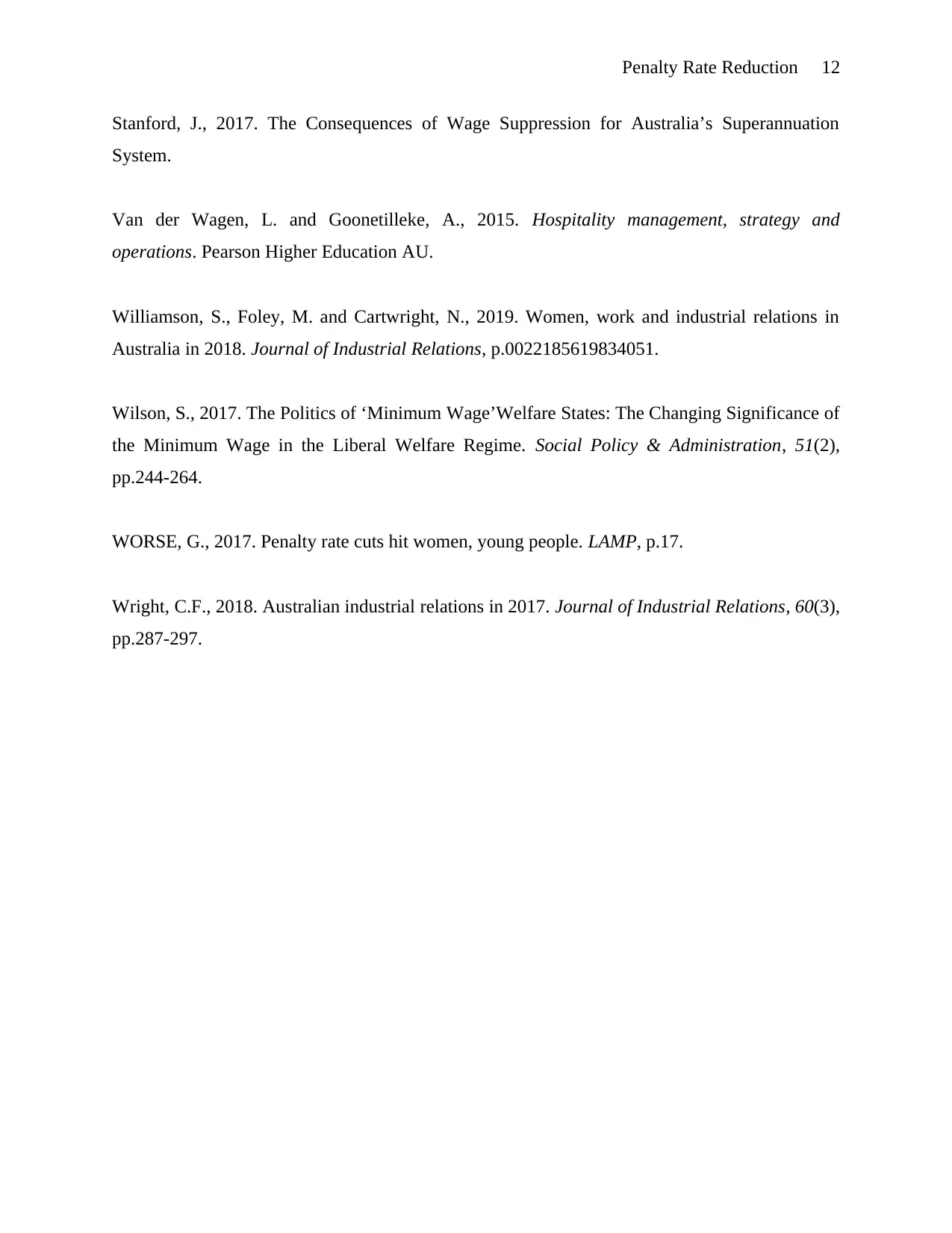
Penalty Rate Reduction 12
Stanford, J., 2017. The Consequences of Wage Suppression for Australia’s Superannuation
System.
Van der Wagen, L. and Goonetilleke, A., 2015. Hospitality management, strategy and
operations. Pearson Higher Education AU.
Williamson, S., Foley, M. and Cartwright, N., 2019. Women, work and industrial relations in
Australia in 2018. Journal of Industrial Relations, p.0022185619834051.
Wilson, S., 2017. The Politics of ‘Minimum Wage’Welfare States: The Changing Significance of
the Minimum Wage in the Liberal Welfare Regime. Social Policy & Administration, 51(2),
pp.244-264.
WORSE, G., 2017. Penalty rate cuts hit women, young people. LAMP, p.17.
Wright, C.F., 2018. Australian industrial relations in 2017. Journal of Industrial Relations, 60(3),
pp.287-297.
Stanford, J., 2017. The Consequences of Wage Suppression for Australia’s Superannuation
System.
Van der Wagen, L. and Goonetilleke, A., 2015. Hospitality management, strategy and
operations. Pearson Higher Education AU.
Williamson, S., Foley, M. and Cartwright, N., 2019. Women, work and industrial relations in
Australia in 2018. Journal of Industrial Relations, p.0022185619834051.
Wilson, S., 2017. The Politics of ‘Minimum Wage’Welfare States: The Changing Significance of
the Minimum Wage in the Liberal Welfare Regime. Social Policy & Administration, 51(2),
pp.244-264.
WORSE, G., 2017. Penalty rate cuts hit women, young people. LAMP, p.17.
Wright, C.F., 2018. Australian industrial relations in 2017. Journal of Industrial Relations, 60(3),
pp.287-297.
⊘ This is a preview!⊘
Do you want full access?
Subscribe today to unlock all pages.

Trusted by 1+ million students worldwide
1 out of 12
Related Documents
Your All-in-One AI-Powered Toolkit for Academic Success.
+13062052269
info@desklib.com
Available 24*7 on WhatsApp / Email
![[object Object]](/_next/static/media/star-bottom.7253800d.svg)
Unlock your academic potential
Copyright © 2020–2025 A2Z Services. All Rights Reserved. Developed and managed by ZUCOL.





